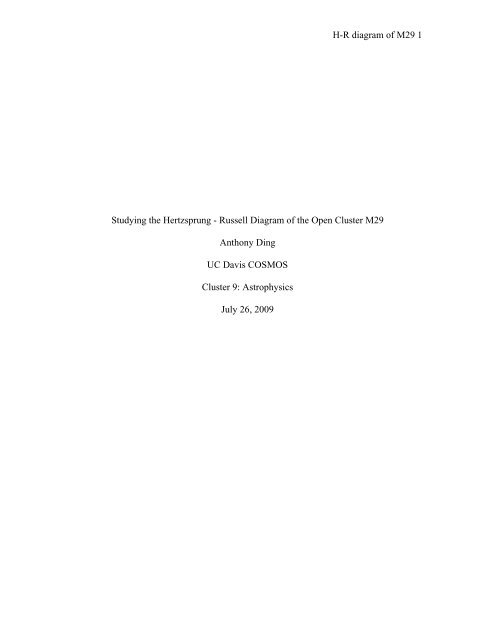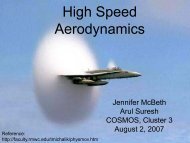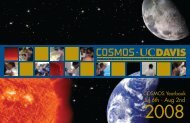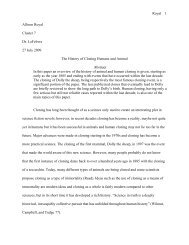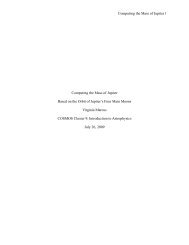Ding, Anthony - COSMOS - UC Davis
Ding, Anthony - COSMOS - UC Davis
Ding, Anthony - COSMOS - UC Davis
You also want an ePaper? Increase the reach of your titles
YUMPU automatically turns print PDFs into web optimized ePapers that Google loves.
H-R diagram of M29 1<br />
Studying the Hertzsprung - Russell Diagram of the Open Cluster M29<br />
<strong>Anthony</strong> <strong>Ding</strong><br />
<strong>UC</strong> <strong>Davis</strong> <strong>COSMOS</strong><br />
Cluster 9: Astrophysics<br />
July 26, 2009
H-R diagram of M29 2<br />
Abstract<br />
The goal of this study is to plot and study the H-R diagram of the open cluster M29. The<br />
H-R diagram can have different values plotted on the x and y axes; in this study, the x-<br />
axis represents the B-V value and the y-axis represents the V magnitude. Data used in<br />
this study was collected by a 25-cm diameter Cassegrain telescope through a B filter and<br />
a V filter. The raw data was cleaned, processed, and combined in CCDSoft and the<br />
resulting images were plugged into SExtractor to obtain a list of all the stars in the images.<br />
The stars were then plotted with Microsoft Excel to obtain an H-R diagram. The method<br />
used to procure a rough estimate of the age of M29 is discussed in detail and, using the<br />
diagram, the age of M29 is estimated to roughly 10-100 million years old. If more studies<br />
and analyses are performed, much more information can be plucked from the H-R<br />
diagram of M29.
H-R diagram of M29 3<br />
Studying the Hertzsprung-Russell Diagram of the Open Cluster M29<br />
Thousands of years ago, astronomers were interested only in counting the number<br />
of stars in the night sky. Today, they are interested in categorizing them and learning<br />
more about the lives of stars. The Hertzsprung-Russell diagram, which was developed in<br />
the early 1900s, organizes groups of stars in such a way that a pattern immediately<br />
becomes obvious to the eye (Spence and Garrison 1993). The diagram is plotted with a<br />
star’s temperature on the x-axis, and its luminosity on its y-axis. The temperature<br />
decreases going right, and the luminosity increases going up. This set-up allows scientists<br />
to compare the brightness’s and luminosities of two or more stars by plotting them on the<br />
diagram. Because a star’s luminosity can also be represented by its magnitude, it is<br />
possible to graph the magnitude in place of the luminosity on the y-axis. In addition, the<br />
temperature of a star corresponds to its color and spectral type, and both color and<br />
spectral type can be inserted in place of the temperature.<br />
Generally, stars plotted on an H-R diagram are the same distance away from the<br />
Earth so that their magnitudes are comparable. Stars have two types of magnitudes,<br />
apparent, and absolute. A stars apparent magnitude describes its magnitude as it looks to<br />
the eye, disregarding its distance. A star’s absolute magnitude describes a star’s<br />
magnitude at a set distance, 10 parsecs, or 100,000 km (Scheider and Arny 2009). In<br />
order to convert from apparent magnitude to absolute magnitude, the distance from the<br />
star to the Earth must be known. Therefore, it is much easier to convert the magnitude if<br />
all the stars are the same distance away from Earth because only one distance has to be<br />
used, as opposed to hundreds of distances if the stars are at different distances from Earth.
H-R diagram of M29 4<br />
This is why star clusters, in which all the stars are the same distance away from the Earth,<br />
are ideal stellar objects to plot on H-R diagrams.<br />
There are two possible type of star clusters, open, also known as galactic, star<br />
clusters and globular star clusters (Schneider and Arny 2009). The major difference<br />
between the two is that an open cluster is relatively young with well-dispersed stars and<br />
an unsymmetrical shape, while globular clusters are relatively old with concentrated stars<br />
and spherical shape. M29, also known as NGC 6913, is an open cluster located in the<br />
constellation Cygnus. Open clusters are born through the condensation of a single gas<br />
cloud (Schneider and Arny 2009). This means that in addition to being roughly the same<br />
age, the stars in an open cluster will be the same distance from Earth and have the same<br />
chemical composition (Frommert and Kronberg 2007). Because many of the properties of<br />
stars in an open cluster are the same, plotting the stars on an H-R diagram is very useful<br />
for comparing the properties that aren’t the same.<br />
When you plot an open cluster on an H-R diagram, you get a characteristic line<br />
starting from the top left, flattening out in the middle, and ending in the bottom right.<br />
This sequence of stars is called the main sequence (Schneider and Arny 2009). In general,<br />
stars in the main sequence are newly formed and burn through a process of nuclear fusion,<br />
where hydrogen nuclei are fused to create a helium nuclei; in fact, our sun is one such<br />
main sequence star. Stars spend most of their lives in the main sequence. As their fuel<br />
burns out, the stars will eventually branch out of the main sequence. Stars that are in the<br />
middle of their lifetimes can be found in the Red Giant branch, where they will<br />
eventually burn out completely and turn into a white dwarf star (Iben 1966). In addition,<br />
some stars may take an alternate path and branch off into what is known as the Horizontal
H-R diagram of M29 5<br />
branch; stars in the Horizontal branch are remnants of past Red Giant branch stars<br />
(Catelan 2009). The location of stars in these branches can then be analyzed to determine<br />
the age of the star cluster. The determination of a star’s age can lead to further knowledge<br />
of stellar evolution: a study of the lifetime and evolution of a star.<br />
Data<br />
The data used in this study was collected from a Takahashi Cassegrain Reflecting<br />
telescope with a 25-cm diameter lens. Images were captured by a SBig ST8 SE chargecoupled<br />
device, or CCD, with a quantum efficiency of 60%, meaning that 60% of the<br />
light photons that hit the CCD were recorded. All data was taken in 15 second exposures<br />
on July 9 th and July 13 th at the Placerville Rotary Community Observatory. A total of 24<br />
exposures were taken, 12 with a B filter and 12 with a V filter. The B filter lets in light<br />
closer to the blue wavelength and the V filter lets in lights closer to the green and yellow<br />
wavelengths. The raw data was then uploaded to a computer and processed with<br />
CCDSoft, image processing software for CCD images and data reduction.<br />
Analysis<br />
To begin the process of data reduction, five dark exposures were taken at varying<br />
exposure times and CCDSoft was used to divide the dark exposures to make them all<br />
express an exposure time of 15 seconds, the exposure time of our data. Next, we median<br />
combined the dark exposures to create a master dark image. The CCD is not perfect, and<br />
sometimes, it records cosmic rays or ‘ghost’ photons which are not really there. To clean<br />
up the image, counts due to cosmic ray hits and extra photons must be correctly identified<br />
and removed. To do this, the dark images are combined to determine the location of<br />
incorrect counts. After creating the master dark image, we subtracted it from the original
H-R diagram of M29 6<br />
images to obtain clean images. Separately, the blue filter images and visual filter images<br />
were then aligned and combined to create a total of two images.<br />
Image of M29 through B filter<br />
Image of M29 through V filter<br />
After that, we created a list of objects in the images using CCDSoft, and then transferred<br />
the list and the images to a different piece of software, SExtractor. Through SExtractor,<br />
we were able to obtain an SRC file with data on the entire list of identified objects in the<br />
images, including their coordinates and magnitudes. We were then able to access the data<br />
by opening the file with Microsoft Excel.<br />
After the SRC file was extracted from the image, we isolated the x and y<br />
coordinates and the magnitudes for both the B and V images. We then located certain<br />
stars in the B and V images with CCDSoft and matched their coordinates in the SRC files<br />
to find the magnitude of specific stars. However, there is a constant difference between<br />
the star’s true magnitude, and the magnitude given to us by CCDSoft and SExtractor due<br />
to differences in equipment, viewing conditions, and filters among others. Because of this<br />
constant difference, we needed to use an outside article (Boeche, Munari, Tomasella, and<br />
Barbon 2004) that listed the true magnitudes of the stars. Knowing the true magnitudes of<br />
the stars for the B and V images, we were able to determine the difference between the<br />
true magnitude values and the values in our Excel file. After finding the difference
H-R diagram of M29 7<br />
several times, we averaged the difference to come up with a constant. The average B<br />
constant of 12.793 and the average V constant of 10.61655 were then added to the B and<br />
V magnitudes to come up with new magnitudes for the two. Because the H-R diagram is<br />
plotted with the V magnitude on the y-axis and the B-V value on the x-axis, the last thing<br />
to calculate was the B-V values. After obtaining the V and B-V values, the data points<br />
were graphed as a scatter plot in Excel.
H-R diagram of M29 8<br />
Conclusion<br />
Although it is a little bit off, the H-R diagram of M29 represents the typical H-R<br />
diagram of a cluster of stars. The line of data points stretching from the bottom left to the<br />
middle is what is known as the main sequence, where most of the stars are. The almost<br />
vertical line branching out of the main sequence is known as the Red Giant branch. With<br />
knowledge about these two branches, it is possible to estimate the age of M29. In order to<br />
do this, it is necessary to locate a star just about to leave the main sequence and just about<br />
to enter the Red Giant branch. In other words, we need to find the “turning point”. Once<br />
we find the star, we need to convert that star’s B-V value into its temperature, and then<br />
into its spectral type. Knowing its spectral type, we can then match the star up with a<br />
table that compares a star’s spectral type to its average lifetime in the main sequence.<br />
This estimated age is correct because the lifetime given is the lifetime in the main<br />
sequence, and the star chosen is one just about to leave the main sequence. And since all<br />
stars are born at the same time in a star cluster, we can say that the age of the star is<br />
roughly equal to the age of the cluster. In the case of M29, the turn-off point is within an<br />
approximate range of -0.09 to 0.1. Using a chart that matches temperature B-V values to<br />
temperature (Sloan Digital Sky Survey n.d.), we know that this corresponds to a<br />
temperature range of about 11,000K to 9,000K. Using another chart, we know that the<br />
particular stars in the turning point range are spectral type B stars (Nave 2009). This tells<br />
us that the star, and thus the cluster, is around 10 million to 100 million years old (Wilcox<br />
2005). The actual estimated age of M29, using much more accurate data, is 10 milion<br />
years old (Frommert and Kronberg 2007). The large range of 10 million to 100 million<br />
calculated with the data from this paper is due to the fact that open clusters are spread out,
H-R diagram of M29 9<br />
meaning that taking an image of an open cluster will inherently contain stars in front of<br />
and behind the cluster that are not part of the actual cluster, meaning, if more accurate<br />
data could be obtained, the age of M29 could potentially be measured to a more<br />
reasonable degree of accuracy. Besides calculating a star cluster’s age, it is also possible<br />
to determine the cluster’s distance from Earth using the H-R diagram. While this study<br />
was only aimed at producing an H-R diagram for M29, an open cluster, it is possible to<br />
create an H-R diagram for any grouping of stars, yielding a much larger volume of data<br />
and information of the vast numbers of stars in space.
H-R diagram of M29 10<br />
References<br />
Boeche, C., Munari, U., Tomasella, L., & Barbon, R. (2004). Kinematics and binaries in<br />
young stellar aggregates. II. NGC 6913=M29. Astronomy and Astrophysics, 415,<br />
145-154. Retrieved July 28, 2009, from SAO/NASA Astrophysics Data System.<br />
Catelan, M. (2009). The ages of stars: The horizontal branch. The Ages of Stars,<br />
Proceedings of the International Astronomical Union, IAU Symposium, 209-220.<br />
Retrieved July 12, 2009, from SAO/NASA ADS Astronomy Abstract Service.<br />
Frommert, H., & Kronberg, C. (2007, August 27). Open Star Clusters. Retrieved July 10,<br />
2009, from: http://messier.obspm.fr/open.html<br />
Iben, I. J. (1966). Stellar Evolution.VI. Evolution from the Main Sequence to the Red-<br />
Giant Branch for Stars of Mass 1 M_{sun}, 1.25 M_{sun}, and 1.5 M_{sun}.<br />
Astrophysical Journal, 147, 624-649. Retrieved July 28, 2009, from SAO/NASA<br />
Astrophysics Data System.<br />
Nave, C. R. (2009). Star Spectral Classification. Retrieved July 28, 2009, from<br />
http://hyperphysics.phy-astr.gsu.edu/Hbase/starlog/staspe.html<br />
Schneider, S. E., & Arny, T. T. (2009). Pathways to Astronomy (2 nd ed.). New York:<br />
McGraw Hill.<br />
Sloan Digital Sky Survey. (n.d.). Finding the Radius of a Star. Retrieved July 28, 2009,<br />
from: http://cas.sdss.org/dr6/en/proj/advanced/hr/radius1.asp<br />
Spence, I., & Garrison, R. F. (1993). A Remarkable Scatterplot. The American<br />
Statistician, 47(1), 12-19. Retrieved July 26, 2009, from JSTOR.<br />
Wilcox, R. M. (2005). Stellar Evolution. Retrieved July 28, 2009, from<br />
http://www.stellar-database.com/evolution.html


